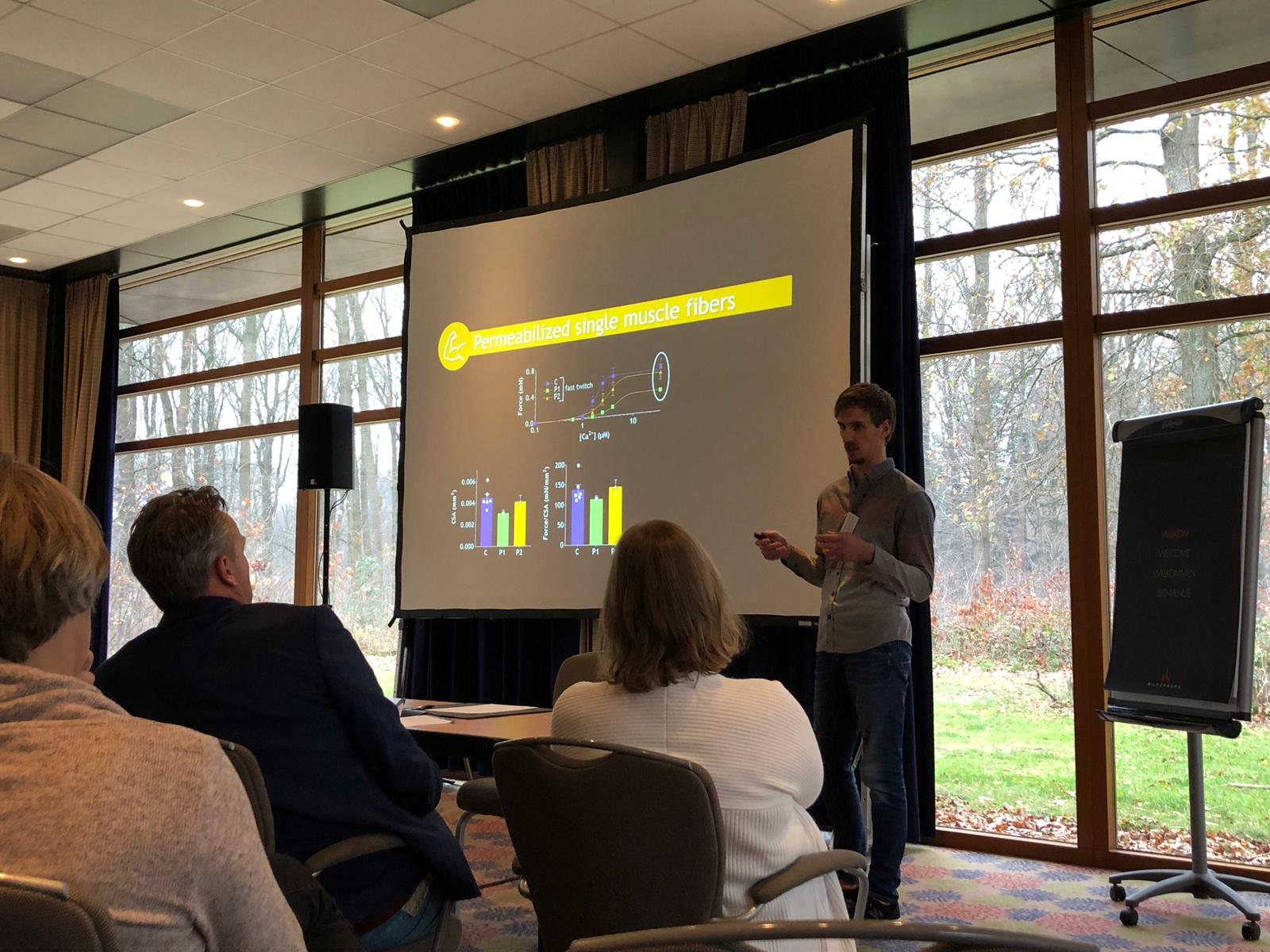
On the 22th and 23rd of November the Dutch Physiology Days (Nederlandse Vereniging voor Fysiologie) took place again and Martijn van de Locht (PhD student in the Ottenheijm group) went home with the prize for best oral presentation! Please see below for his abstract.
MUTATIONS IN FAST SKELETAL TROPONIN C (TNNC2) CAUSE CONTRACTILE DYSFUNCTION
Martijn van de Locht1, Josine M. de Winter1, Stefan Conijn1, Weikang Ma2, Michiel H.B. Helmes1,3, Tom C.
Irving2, Sandra Donkervoort4, Payam Mohassel4, Livija Medne5, Colin Quinn6, Osorio L.A. Neto4, Steven
Moore4, A. Reghan Foley4, Nicol C. Voermans7, Carsten G. Bonnemann4, Coen A.C. Ottenheijm1.
1 Department of Physiology, VU University Medical Centre, Amsterdam, The Netherlands;
2 Biophysics Collaborative Access Team, Center for Synchrotron Radiation Research and Instrumentation, and
Department of Biological Sciences, Illinois Institute of Technology, Chicago, Illinois, USA;
3 IonOptix Llc.,Milton, MA, USA;
4 Neuromuscular and Neurogenetics Disorders of Childhood Section, Neurogenetics Branch, National Institutes
of Neurological Disorders and Stroke, National Institutes of Health, Bethesda, MD, USA;
5 Roberts Individualized Medical Genetics Center, Children’s Hospital of Philadelphia, Philadelphia,
Pennsylvania, USA
6 Department of Neurology, University of Pennsylvania, Philadelphia, PA, USA
7 Department of Neurology, Radboud University Medical Centre, Nijmegen, Netherlands.
Nemaline myopathy (NEM) is a group of rare muscle diseases caused by mutations in genes encoding proteins associated with the thin filament. However, not all thin filament myopathies manifest with characteristic nemaline rods and the spectrum of clinical manifestations is expanding. Troponin C (TnC) binds to TnT and TnI to form the Tn-complex, which regulates thin filament activation. To date, fast skeletal (fs)TnC has not been implicated in disease. Here, we investigate muscle biopsies of two patients with heterozygous, predicted to be damaging mutations (Patient 1 (P1), 27 yrs: c.100G>T; p.Asp34Tyr & patient 2 (P2), 19 yrs: c.237G>C; p.Met79Ile) in the gene encoding fsTnC (TNNC2), manifesting clinically as a unique congenital myopathy. P1 had congenital weakness and vocal cord paralysis requiring tracheostomy, with ptosis, opthalmoplegia, osteopenia and clinical improvement over time. Also, a brother, mother and maternal grandmother, presenting with similar symptoms were found to carry the TNNC2 mutation. P2 has a milder phenotype, with early respiratory weakness, dysphagia and generalized hypotonia, which improved with age, resulting in normal ambulance with mild proximal weakness at age 19. To investigate the mechanism underlying muscle weakness, we performed contractility measurements on single muscle fibers isolated from patient (N=2) and control (N=5) biopsies. Permeabilized fibers were activated by exogenous calcium. P1 showed atrophied type II and hypertrophied type I fibers (confirmed by histochemical analysis). Absolute and normalized maximal force was decreased in type II and increased in type I fibers. The calcium-sensitivity of force was decreased in type II and increased in type I fibers. P2 showed similar results but less pronounced: a lower decrease in calcium-sensitivity of force in type II fibers, no loss of maximal force and no atrophy in type II fibers. In P1, low angle X -ray diffraction data suggested a compressed thin filament in both fiber types, as suggested by shortening of the actin layer line 6 reflection. X-ray data from P2 showed less pronounced changes. Based on these findings, we propose that the TNNC2 mutations reduce the calcium sensitivity of force, presumably due to changes in thin filament structure, contributing to muscle weakness in patients. The more severe clinical phenotype of P1 compared to P2 is reflected in the experimental results.
